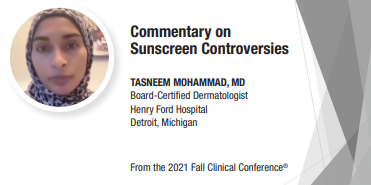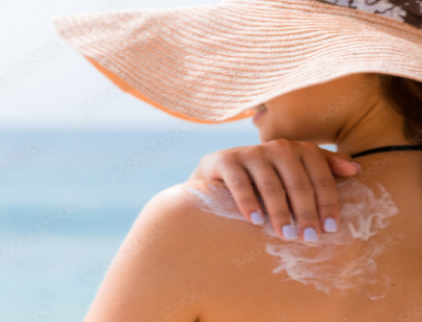Dr. Tasneem Mohammad discusses patient perceptions of risk related to several sunscreen controversies that can impede compliance thereby increasing the risk for skin cancer and pigmentary disorders.

“As dermatologists, it’s really our duty to be able to know about all of these [sunscreen] controversies, know the evidence behind it, and be able to counsel not only our patients but the public in general about what the issues are and how to navigate them,” said Tasneem Mohammad, MD, who presented “Sunscreen Controversies” at the 2021 Fall Clinical Conference®.
Controversies, including chemical and nanoparticle absorption, lichen planopilaris, and the recent benzene recalls, can impede patient compliance, thereby increasing risk of skin cancer and pigmentary disorders.
“At the end of the day, we need to be able to talk to the public about these issues. But at this time, I definitely continue to recommend sunscreen use as part of a total photoprotective package.”

Sunscreen absorption
Research has shown that active ingredients in chemical sunscreens are absorbed into the bloodstream.
“I think this scared a lot of consumers because no one likes to know that they’re absorbing a bunch of chemicals into their body,” said Dr. Mohammad.
In clinical studies of avobenzone, oxybenzone, octocrylene, homosalate, octisalate, and octinoxate, to date, the Food and Drug Administration (FDA) has not found that any are unsafe for human use and continues to strongly advise the American public to wear sunscreens.
“Today, we don’t have any evidence showing that the absorption of sunscreen has any clinical relevance and that it’s having ill effects on our health,” said Dr. Mohammad. “I think the messaging that we need to tell our patients is that first of all, further testing is going to be performed because of these results… [and] we should still counsel our patients to wear sunscreens regularly.”
For safety concerns regarding nanoparticle absorption, she noted that “those have been debunked and I think those are very safe.”
Lichen planopilaris
Sunscreen use has been associated with lichen planopilaris, but according to Dr. Mohammad, the evidence is weak and does not outweigh the benefits of concerned patients who are at risk for developing skin cancer.
“We really have to weigh the risks and benefits of what we tell patients. Especially with lichen planopilaris, I do tell all my patients to use sunscreen. Whatever kind of sunscreen [organic or inorganic] you like, I would use… Both have been implicated in this association. So for me, I say, we know that sunscreen use has a lot of benefits in terms of chemoprevention and preventing pigmentary disorders. And the evidence [linking sunscreen to lichen planopilaris] just isn’t there at this time, but we do need to look into it more.”
Oxybenzone
According to Dr. Mohammad, the controversies with the ingredient oxybenzone are related to possible effects on the endocrine system and coral reefs.
The studies were primarily “rat and fish models where you have to apply an enormous amount of oxybenzone that doesn’t really reflect real-life use.”
And while human studies to date have shown some endocrine alterations, current evidence does not support a causal relationship, said Dr. Mohammad.
“I think the main thing to remember is, association does not equal causation.”
According to Dr. Mohammad, in terms of coral reef bleaching, there is a lack of sound scientific proof. While in vitro studies have shown some affect, nothing has been done in vivo to show that, she noted.
“Also, when you look at one in vitro study, you can’t really generalize all those results to real-life situations and likely there are a lot of other factors contributing to coral reef bleaching.”
Benzene recalls
“When I talk to patients about the benzene contamination, I talk about the way that they did the study,” said Dr. Mohammad.
Valisure examined organic and inorganic sunscreen and aftersun products and found benzene contamination in all three categories. The independent testing agency, therefore, concluded the contamination was part of the manufacturing process.
“That tells us that it’s not any quality inherent to the filters that was causing the presence of benzene because even these aftersun products had benzene in them as well.”
Valisure has a list of sunscreens they tested that do and don’t have benzene, which patients can use to cross reference the products they’re using, said Dr. Mohammad.
“So I usually will just tell patients, take a look at this list and make sure the product that you’re using is okay. For people who have a product that’s not on either one of those lists and they just really love their sunscreen, Valisure is actually offering free product testing so they can send their sunscreens in to get tested.”


